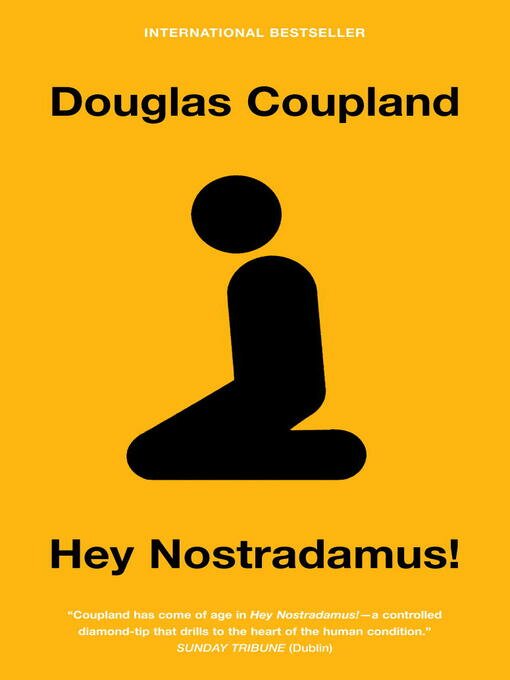If someone was to ask me what the future of Canadian art and culture looked like, I would point them to the work of Douglas Coupland, the influential author, playwright and visual artist. How influential is he? Chances are you know a Generation X-er, or that you are one. If so, you can thank Coupland, because he invented the term.
Unlike the other authors I’ve introduced, however, Coupland doesn’t exactly belong at the commanding heights of High Canadian Culture, because he is an obsessive chaser of the zeitgeist, and like many of the Canadian directors, actors, musicians and other personalities I will introduce going forward- he keeps one foot on either side of the 49th parallel. As such, he has been (somewhat justly) accused of lacking depth, but he more than makes up for that in accessibility.
Though he was born in Germany and spent time studying art in Japan, Coupland has always been identified with Canada’s Westernmost frontier, the province of British Columbia – a place of thick, dark forests, high mountains, grinding downtown poverty and suburban excess, radical leftism and social conservatism, and most of all, driving, cold rain. Like his province, and like his subject matter, Coupland’s art is bright and eye-catching, but it has a deep melancholy running through it. He hopes for a future free from low-paid and soul-crushing work – and if you have ever used the term “McJob“, again, you can thank Coupland for inventing it. He never loses sight of the zany and ironic – he scanned the heads of Canadian shoppers walking through department stores to create a 3D-printed National Portrait. He even has his own font black, boldface Helvetica, which he shares with ubiquitous and down-market Canadian grocery store No Name. His writing is breezy, but never superficial, as this excerpt from his meditation on faith and loss, Hey Nostradamus! clearly shows:
As far as I could tell, Jason and I were the only married students ever to have attended Delbrook. It wasn’t a neighborhood that married young. It was neither religious nor irreligious, although back in eleventh-grade English class I did a tally of the twenty-six students therein: five abortions, three dope dealers, two total sluts, and one perpetual juvenile delinquent. I think that’s what softened me up for conversion: I didn’t want to inhabit that kind of moral world. Was I a snob? Was I a hypocrite? And who was I to even judge? Truth be told, I wanted everything those kids had, but I wanted it by playing the game correctly. This meant legally and religiously and — this is the part that was maybe wrong — I wanted to outsmart the world. I had, and continue to have, a nagging suspicion that I used the system simply to get what I wanted. Religion included. Does that cancel out whatever goodness I might have inside me?
What this paragraph doesn’t tell you is that Cheryl (the narrator) has just discovered she is pregnant (which adds a whole new dimension to the words ‘whatever goodness I might have inside me’!), about to be murdered in a school shooting and will spend an unspecified amount of time in a limbo-state, but it raises enough tough questions on its own. Is she a sinner, or is she appropriately following religious doctrine? Is she selfish and calculating, or just a kid trying to figure life out? Does she deserve her fate? This is the thorny, complex, earnest, searching but never hopeless type of Canadian culture Coupland has successfully exported.
And this is why I see Coupland as an example of the somewhat-hopeful, somewhat-avant-garde, and somewhat-Canadian future of Canadian culture. He is proudly Canadian, but not afraid to engage with American ideas. He does not sweep the ugly parts of life under the rug like Leacock or Montgomery, but neither is he a prophet and iconoclast like Richler. He does not sermonize like Atwood, dissemble like Boyden, or keep things dry and academic like Davies or Findley. He may be a singular force like Edugyan instead of a leader of a Canadian culture movement, but he is, slowly, inspiring other Canadians (like me!) to be culture creators.
As we move now from our study of Canadian authors to the more visual parts of Canadian culture, we will see more of these auteurs, imposing their vision despite the controlling and confining Canadian spaces from which they originate. But before we jump into the bizarre world of David Cronenberg and Canadian film, we’ll quickly explore a cultural movement that is not Canadian, but has more than its fair share of Canadian participants: Jordan Peterson, Steven Crowder, Lauren Southern, Gavin Mcinnes, Stefan Molyneux, and even former Canadian Prime Minister Stephen Harper.
Join me next week when we ask the question: Is the Intellectual Dark Web a Canadian conspiracy?
********
See the previous installments in the series:
Part 1 on Heroes: ‘Scott Pilgrim Vs The World’ Vs Terrance Denby and ‘Sidequest’
Part 2 on “Humour”: The Libertarian Fantasy of ‘Letterkenny’
Part 3 on Graphic Novel Nihilism: The Harsh Truths of ‘Essex County’
Part 4 on Spawn and Wolverine: Banished From The Promised Land: A Tale of Two Canadian Anti-Heroes
Part 5 on Science Fiction Dystopias: Inside Quebec’s – and Canada’s – Replicant Culture
Part 6 on Animation: The Garrison Mentality: More Than Meets The Eye
Part 7 on Pop Music: How To Build A Successful Canadian Musical Act
Part 8 on Anne of Green Gables and The Traumatized Artist: Lucy Maud Montgomery’s Treacherous Alpine Path
Part 9 on Avoiding the Serious: Mordecai Richler, Montreal, And Gritty Realism
Part 10 on Southern Ontario Gothic: The Marriage of the Mundane and the Fantastic
Part 11 on Margaret Atwood’s Reign of Terror: Literary Tyranny and The Handmaid’s Tale
Part 12 on the First Nations Fraud: Whitewashing Genocide: Truth, Lies, and Joseph Boyden
Part 13 on the inventive Esi Edugyan: A Novel I Cannot Recommend Enough



Comments
Leave a Reply